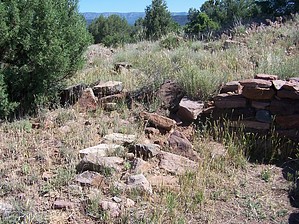| Guide | ♦ | 13 Triplogs | 0 Topics |
details | drive | no permit | forecast | route |
stats |
photos | triplogs | topics | location |
| 71 | 13 | 0 |
Rim country ruins by Crzy4AZ  This area was occupied from 1000-1250 AD by people related to Salado and Hohokam. The whole site contains some 80 or 90 structures on four acres surrounded by a three-foot wall. There is a short walking tour around some of the partially excavated buildings. The site was first discovered in 1930 and finally excavated in 1984. This area was occupied from 1000-1250 AD by people related to Salado and Hohokam. The whole site contains some 80 or 90 structures on four acres surrounded by a three-foot wall. There is a short walking tour around some of the partially excavated buildings. The site was first discovered in 1930 and finally excavated in 1984.From Tonto Forest Service brochure: Up until about A.D. 1000, the people of the Payson area lived in small settlements made up of only a few families each. As the need to share labor for farming or defense grew, villages like Shoofly Village developed.
Shoofly Village was built and occupied between A.D. 1000 and 1250 by people who had close cultural ties to the Hohokam and Salado people living in the deserts and mountains to the south. By the time the village was established, however, they had developed their own distinctive culture. The village contains 87 rooms and many courtyards, all surrounded by a compound wall that encloses about four acres. It is arranged into three groups of rooms constructed at different times during the history of the site. The single unit, oval-shaped rooms are the earliest, with the rectangular rooms, particularly clustered into the large block at the center of the site, built later. Many of the rooms appear to have been occupied at the same time. The walled courtyards suggest that families or other small social groups maintained separate identities within the village. The compound wall was built during the late period of construction. The boulders of dark basalt used in the wall contrast against the red sandstone used in most of the rooms. The wall was at least three feet high and may have been higher. The fact that no houses are found outside the wall suggests that it was built for protection. The discovery of a lot of corn in the rooms along with many grinding stones indicates that agriculture was important in the village's economy. Nearby springs supplied water for domestic use. Check out the Official Route and Triplogs. Leave No Trace and +Add a Triplog after your hike to support this local community. | ||||||||||||||||||||||||||||||||||||||||||||||||||||||||||||||||||||||||||||||||||||||||||||||||
 Route Editor
Route Editor




